
* World War II was the great age of the big military flying boat, producing famous aircraft such as the American PBY and the British Sunderland. The Japanese provided their own contributions to the art in the form of the Kawanishi "H6K" and "H8K" flying boats. This document provides a history and description of the H6K and H8K, plus notes on the "Aichi H9A" seaplane, produced as a trainer for the H8K.
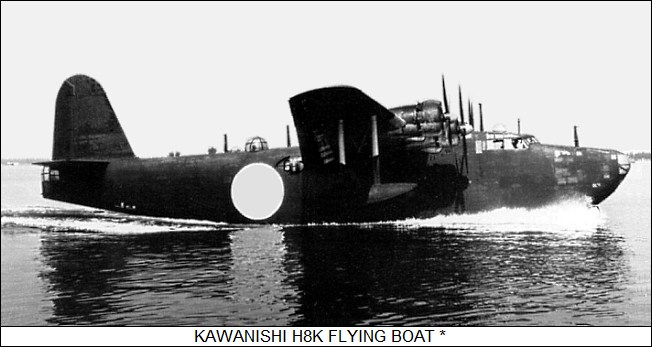
* In 1933, the Imperial Japanese Navy (IJN) issued a requirement for an experimental large flying boat. Kawanishi submitted two designs for monoplane flying boats, including the "Type Q" with four engines, and the "Type R" with three. The IJN puzzled over these submissions for a time, then issued a revised specification in early 1934. Kawanishi replied with a new design, the "Type S", evolved from the two earlier submissions. The Type S was accepted, and the first of four prototypes of the "H6K1", as the IJN designated it, performed its initial flight on 14 July 1936, with Kondo Katsuji at the controls. Service trials began at the end of the month. The second and third prototypes followed in 1937, and the fourth in 1938.
The H6K1 was designed by a team under Hashiguchi Yoshio and Kikuhara Shizuo, leveraging off data provided by a Kawanishi group that had visited Short Brothers in the UK. It was a neat prewar flying boat design of metal construction, with some similarities to the US Consolidated PBY Catalina, but arguably more attractive, and certainly bigger. The initial prototype had a streamlined hull, a strut-mounted wing with four Nakajima Hikari 2 nine-cylinder air-cooled radial engines with 625 kW (840 HP) each, and a twin-fin tail. It carried a crew of nine.
The H6K1 had light defensive armament of three guns, consisting of a single 7.7-millimeter (0.303-caliber) Type 92 machine gun in a power-driven dorsal turret, and the same weapon on flexible mounts in nose and tail. Offensive armament consisted of two 800-kilogram (1,764-pound) torpedoes mounted on the wing bracing struts, or up to a total of 1,000 kilograms (2,200 pounds) of bombs using a similar carriage scheme.
* Some changes in the design were made during prototype evaluation. The first, third, and fourth prototypes were brought up to full operational fit, re-engined with Mitsubishi Kinsei 43 radials with 745 kW (1,000 HP) each, and delivered to the IJN in January 1938. They were given the designation "H6K1 Type 97 Flying Boat Model 1". These three aircraft were followed by ten basically identical full production aircraft, which were designated "H6K2"; and then two machines built as VIP transports, and designated "H6K3". The H6Ks performed operational missions in the Japanese war in China.
The main production version was the "H6K4", which went into service in 1941. A total of 127 was built. The major changes in this variant were increased fuel capacity and improved armament. The handheld 7.7-millimeter Type 92 gun in the nose was retained, but the dorsal turret was replaced by another handheld 7.7-millimeter gun and the tail position was "up-gunned" to a Type 99 Model 1 20-millimeter cannon. A glass blister was fitted on each side of the rear fuselage, with each blister featuring a Type 92 machine gun on a flexible mount. Offensive weapon load remained as before.
There were actually two subvariants or "blocks" of the H6K4. Initial production was the "H6K4 Model 2-2", which retained the Kinsei 43 engines of its predecessors. From August 1941, production moved to the "H6K4 Model 2-3", fitted with uprated Kinsei 46 radials with 798 kW (1,070 HP) each. Later on, they would both be referred to as "Model 22", with no distinction for the powerplants.
64 H6K4s were in service with the IJN when the Pacific War broke out in December 1941. The type saw considerable action, particularly in the South Pacific, even conducting bombing raids on Rabaul and the Dutch East Indies. The H6K4 had extreme range and endurance, able to undertake 24-hour patrols.
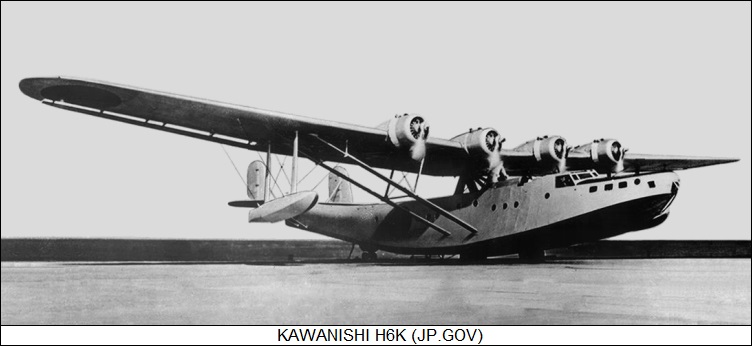
The H6K series was to be replaced by the H8K series, discussed below, but as insurance against production problems with the H8K, in 1941 another variant was introduced, the "H6K5", featuring Kinsei 51 or 53 radials with 970 kW (1,300 HP) each, and the bow gun position replaced by a turret right behind the flight deck, also with a 7.7-millimeter gun. One H6K4 was converted to be the prototype, and it was followed by 36 production H65Ks, the last being produced in 1942.
___________________________________________________________________
KAWANISHI H6K5 FLYING BOAT:
___________________________________________________________________
wingspan:
40 meters (131 feet 3 inches)
wing area:
170 sq_meters (1,830 sq_feet)
length:
25.63 meters (84 feet 1 inch)
height:
6.27 meters (20 feet 7 inches)
empty weight:
12,380 kilograms (27,295 pounds)
MTO weight:
23,000 kilograms (50,705 pounds)
max speed at altitude:
385 KPH (239 MPH / 208 KT)
service ceiling:
9,560 meters (31,365 feet)
range:
6,775 kilometers (4,210 MI / 3,660 NMI)
___________________________________________________________________
* With the introduction of the far more combat-worthy H8K, the H6K was withdrawn from front-line operations, to be used as a military transport. They were fitted with bench seats for troops and apparently retained their armament.
H6Ks were also built as transports from the ground up, with less primitive accommodations. The two H6K3s have already been mentioned. In addition, two of the ten H6K2s built had been converted to a prototype transport configuration in 1939, leading to production of a transport version of the H6K4, with the Kinsei 43 radials. These machines were perversely designated "H6K2-L". They were unarmed, had either 18 passenger seats, or 10 seats and 4 berths; they featured a galley and other niceties. A total of 16 new-build H6K2-Ls was produced into 1942. They were then followed by production of 20 "H6K4-L" transports with Kinsei 46 radials and more windows. Two more H6K4-Ls were produced as conversions from H6K4s.
Of these 38 machines, 20 of them remained in IJN service, while the remaining 18 were used by the Dai Nippon Koku KK airlines in more or less commercial service. A total of 215 H6Ks were produced, variants including:
The H6K remained in transport service to the end of the war, and a few were apparently used in Indonesia for a few years after the conflict. It does not appear that any have survived to this day.
BACK_TO_TOP* In 1938, even as the H6K was going into service, Kawanishi was working on its replacement. The Japanese Navy wanted a flying boat that was 30% faster, had 50% greater range, and better defensive capability. The result was a clean, high-wing monoplane design. The prototype, which was designated "H8K1", was originally intended to have retractable floats, but these were deleted in favor of fixed floats to save weight before the prototype was completed on 31 December 1940. It was powered by four 1,140 kW (1,530 HP) Mitsubishi MK4A Kasei ("Mars") 11 engines, a 14-cylinder two-row air-cooled radial design based on Pratt & Whitney technology.
The prototype proved to be very unstable on the water and prone to "porpoising". Many changes were made to improve its seaworthiness, including an 11% increase in the depth of the hull. Two preproduction machines followed the prototype. They used the same engine fit but incorporated further hull improvements, and the third machine was fitted with an enlarged tailfin.
The engineers worked the bugs out and the type was formally put into production in 1941 under the designation "H8K1 Type 2 Model 11". Production models of the H8K1 had a crew of ten, and were fitted a Type 99 Model 1 20-millimeter cannon in dorsal and tail turrets. It is unclear if the turrets were power driven. Single 7.7-millimeter Type 92 machine guns were placed in blisters on each side of the fuselage, as well as in the nose and a ventral hatch.
Offensive payload was eight 250-kilogram (550-pound) bombs or two 800-kilogram (1,764-pound) torpedoes, carried under the wings. Late production machines had MK4B Kasei 12 engines, with technical improvements but no change in power. The H8K's water handling was inferior to that of the H6K, but its flight performance was much superior.
The H8K1 had eight small fuel tanks in the wings and six large tanks in the fuselage. The wing tanks were unprotected, while the fuselage tanks were partly self-sealing and had a carbon dioxide fire extinguishing system. If punctured, the fuselage fuel tanks drained into a bilge where the fuel could be pumped back into undamaged fuel tanks. The relative vulnerability and small size of the wing tanks suggests that they were to be drained first in a mission, which would have also improved the aircraft's handling.
The first serious operational use of the H8K took place in March 1942, in an attempt to perform a second air raid on Pearl Harbor. The three H8K1s involved were based in the Marshall Islands, which were roughly 3,700 kilometers (2,000 nautical miles) from the island of Oahu. That was beyond the round-trip range even of the H8K1, and so the flying boats were refueled by submarine at a waypoint. However, on arrival at the target, the aircraft found the target area socked in with heavy clouds, and had to call off the attack. An attempt to try again a few months later was frustrated by the presence of American forces at the refueling point. This operation ended up being a great deal of effort expended to no good end; even if the raid had gone off as planned, it would have been a futile pinprick to American forces, making it a poor use of resources.
* The 18th H8K flying boat was built with uprated MK4Q Kasei 22 engines, each with 1,380 kW (1,850 HP), plus a modified tailfin and increased fuel capacity, and was given the new designation "H8K2 Type 2 Model 12".
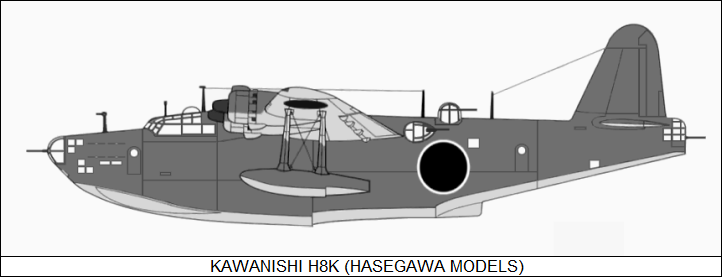
The H8K2 also featured much improved defensive armament, replacing the 7.7-millimeter gun in the nose and each fuselage blister with a 20-millimeter cannon. Flexibly-mounted 7.7-millimeter guns were also added to each side of the fuselage and each side of the cockpit. That gave an impressive total defensive armament of five 20-millimeter cannon and five 7.7-millimeter guns. Given its heavy defensive armament, some Allied pilots nicknamed the H8K2 the "Flying Porcupine". Late production machines had longwave Mark VI Model 1 ocean search radar, with towel-rack transmitter antennas along the nose and Yagi-style receiving antennas under the wings.
___________________________________________________________________
KAWANISHI H8K2:
___________________________________________________________________
wingspan:
38 meters (124 feet 8 inches)
wing area:
160 sq_meters (1,722 sq_feet)
length:
28.15 meters (92 feet 4 inches)
height:
9.15 meters (30 feet)
empty weight:
18,370 kilograms (40,520 pounds)
normal loaded weight:
24,500 kilograms (54,010 pounds)
max loaded weight:
32,500 kilograms (71,650 pounds)
max speed:
465 KPH (290 MPH / 252 KT)
cruise speed:
295 KPH (184 MPH / 160 KT)
service ceiling:
8,760 meters (28,740 feet)
range:
7,150 kilometers (4,440 MI / 3,865 NMI)
___________________________________________________________________
* In the meantime, work had been proceeding on a transport variant of the H8K. The first prototype was modified for this role, being fitted with MK4Q Kasei 22 engines, and was given the designation "H8K1-L". It was followed by 36 similar new-build "H8K2-L" transports, produced between 1943 and 1945.
The transport version was named "Seiku (Calm Sky)", and had accommodations on two decks for 29 passengers, riding in relative comfort, or 64 troops, with less comfortable seating. Most of the hull tanks were removed to allow the passenger / troop accommodations, and defensive armament was reduced to a 13-millimeter Type 2 machine gun in the nose and a 20-millimeter cannon in the tail.
Two experimental variants of the H8K were also developed, but not put into production. The "H8K3" was a modified late-production H8K2 that featured retractable wingtip floats, a retractable dorsal turret, and 20-millimeter cannon mounted in a hatch on each side of the fuselage, replacing the blisters. The hatch arrangement was also featured on late-production H6K2s.
Two H8K3s were built. They were later re-engined with more powerful MK4T-B Kasei 25b engines with 1,360 kW (1,825 HP each), to be redesignated "H8K4". A transport version, the "H8K4-L", was considered, but by that time the military situation was becoming desperate, priority was being given to the production of fighters for the defense of the home islands, and no more H8Ks were built. The final tally of H8K production was 167 machines, variants including:
Imperial Japanese military technology was a very mixed bag, ranging from the impressive to the pathetic, but the H8K was near the top of the scale -- one of the best, some insist the best, flying boats of World War II. The type was evaluated by the Americans after the war, and one survives as a static display in Japan. It was originally at the Maritime Museum in Tokyo, but the museum is on the waterfront, and the aircraft suffered badly from weathering. In 2003, it was relocated to the Kanoya Naval Air Station in Kagoshima, where it could be better protected from the elements.
BACK_TO_TOP* The Aichi company had acquired a good reputation with the IJN with its series of single-engine flying boats before the war. These machines were of a common configuration, being biplanes with a pusher propeller, though of course featuring improvements from model to model. The primary role of these aircraft was to provide reconnaissance support for IJN fleet surface night actions. The ultimate developments of this line, the Aichi "E10A1" and "E11A1" saw some limited firstline service early in the Pacific War, though since they were obsolescent they were quickly reassigned to second-line duties.
In 1940, a team at Aichi under Morishige Mori had begun work on a new flying boat, the "H9A". The purpose of this aircraft was unusual: it was specifically designed to train aircrew for the H8K. The Aichi H9A was one of the few flying boats designed from the outset as a trainer -- which makes a certain amount of good sense, since obviously flying off water is not like flying off a runway, and it might be nice to show a cadet the ropes.
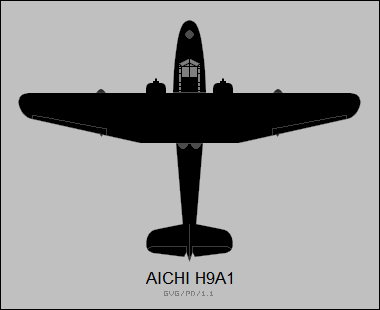
The first of three prototypes performed its initial flight in September 1940. Initial trials revealed a number of problems that required correction. After the bugs were worked out, the machine proved highly satisfactory, and was put into production.
The H9A was a neat, clean machine, something along the lines of a scaled-down H6K, with fixed floats and a parasol wing, powered by twin Nakajima Kotobuki 41 radials with 529 kW (710 HP) each. The aircraft had dual controls, one set for the flight instructor and the other for a pilot trainee, and also carried a flight engineer, radio operator, observer, and up to three students. The aircraft was a pure flying boat, not an amphibian, though it featured built-in, semi-retractable beaching gear. It could be optionally armed with a Type 92 7.7-millimeter machine gun on flexible mounts in the nose and rear, as well as two 250-kilogram (550-pound) depth charges, one under each wing. The weapons were provided primarily for armament training.
___________________________________________________________________
AICHI H9A FLYING BOAT:
___________________________________________________________________
wingspan:
24 meters (78 feet 9 inches)
wing area:
63.3 sq_meters (681.4 sq_feet)
length:
16.95 meters (55 feet 7 inches)
height:
17 meters (17 feet 3 inches)
empty weight:
4,900 kilograms (10,805 pounds)
MTO weight:
7,500 kilograms (16,535 pounds)
max speed at altitude:
315 KPH (195 MPH / 170 KT)
cruise speed:
220 KPH (135 MPH / 120 KT)
service ceiling:
6,780 meters (22,245 feet)
range:
2,150 kilometers (1,335 MI / 1,160 NMI)
___________________________________________________________________
Following the three prototypes, Aichi built 24 machines, while Nippon Hikoki built another four, for a total of 31. H9As were pressed into service near the end of the war for antisubmarine patrol. It does not appear any of them have survived to the present.
BACK_TO_TOP* As another footnote to the tale, in midwar the Kawanishi company began work on a flying boat cargo carrier for the IJN, the aircraft being named the "H11K1 Soku (Blue Sky)". It was of the same general configuration as the H8K and based on it, but it was bigger and tubbier, with distinctive extended cockpit glazing; it had fixed floats and large internal volume to permit haulage of bulky cargoes. It was to haul up to eighty troops on its cargo deck, with cargoes loaded and removed through split nose doors.
The Soku was to be powered by four Mitsubishi MK4Q Kasei 22 (Ha-32-22) radials, each providing 1,380 kW (1,850 HP), with defensive armament of three Type 2 13-millimeter machine guns. Length was to be 37.7 meters (123 feet 8 inches), wingspan 47.97 meters (147 feet 5 inches), and empty weight 26,405 kilograms (58,215 pounds) -- over 40% more than the H8K. Cargo load was to be over 19 tonnes (21 tons). The Soku was to be made of wood and other nonstrategic materials to the maximum extent possible, to conserve increasingly scarce resources. A mockup was completed, but then destroyed in a US bombing raid on 1 April 1945, with the project then abandoned.
* The H6K and H8K are somewhat better known today by their Allied codenames "Mavis" and "Emily". However, the problem with the codename system is that it didn't become popular until late in the war, meaning that in 1942 the names "Mavis" and "Emily" were meaningless; in other words, the codenames are more important in retrospect than they were at the time. German aircraft also had codenames, but nobody uses them today. Given the ambiguity of the matter, it seems wisest just to mention that the codenames existed and otherwise ignore them.
The H8K that had been at the Maritime Museum in Tokyo was one of the more famous aircraft exhibits, and I actually saw an episode of a Japanese animation series named "Taiho Shichauzo (You're Under Arrest)", about two femme Tokyo traffic cops, that rotated around this particular machine. It was a neat intrusion of reality into fantasy.
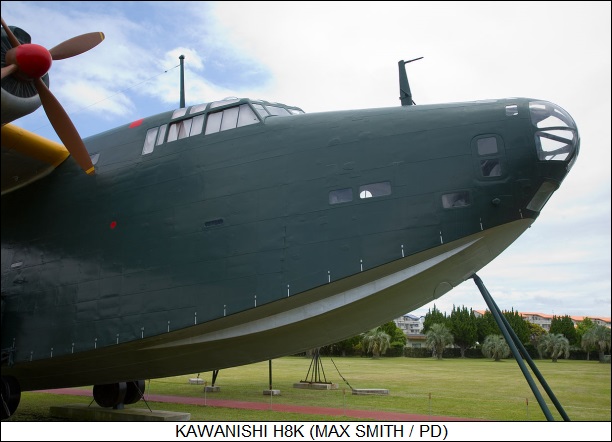
* Sources include:
* Revision history:
v1.0 / 01 may 98 / Original release only on H8K. v2.0.0 / 01 feb 03 / Added H6K & Aichi H9A. v2.0.1 / 01 feb 05 / Review & polish. v2.0.2 / 01 feb 07 / A few minor bug fixes. v2.0.3 / 01 dec 09 / Review & polish. v2.1.0 / 01 nov 11 / Cut references to "Mavis" and "Emily". v2.1.1 / 01 oct 13 / Review & polish. v2.2.0 / 01 aug 15 / Added H11K1 Soku. v2.2.1 / 01 jul 17 / Review & polish. v2.2.2 / 01 jun 19 / Review & polish. v2.2.3 / 01 apr 21 / Review & polish. v2.2.4 / 01 feb 23 / Formatting update. v2.2.5 / 01 feb 25 / Review & polish.BACK_TO_TOP
